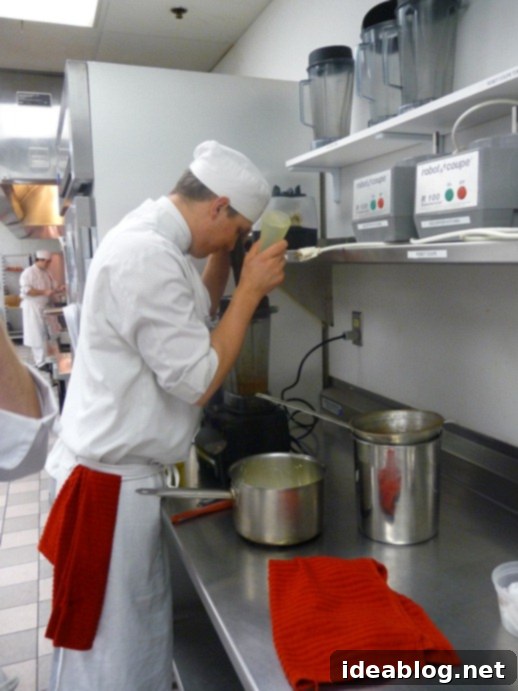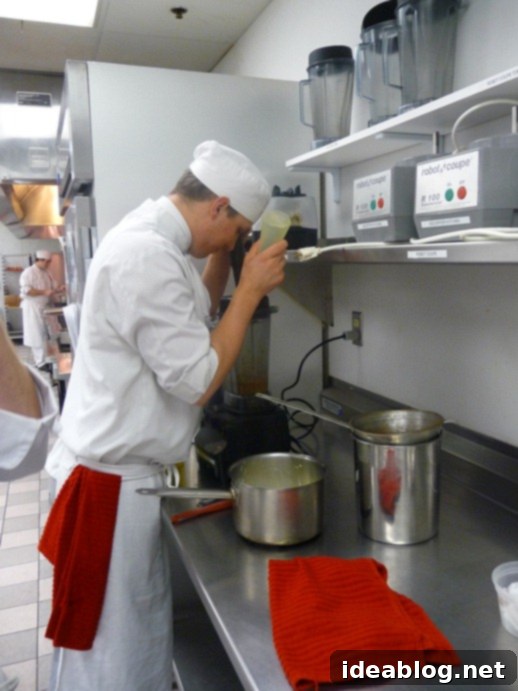Unveiling the Future of Food: A Deep Dive into Molecular Gastronomy in Culinary School
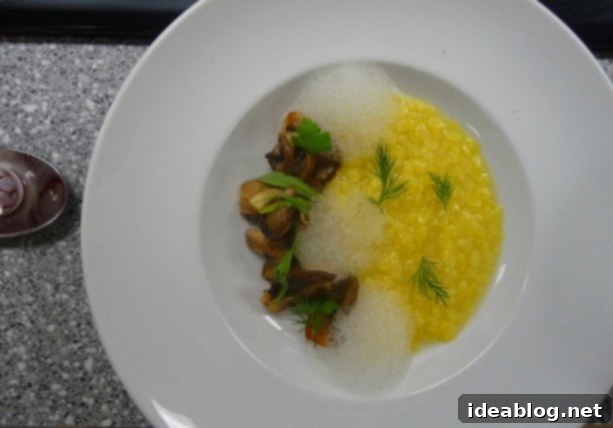
Zucchini “Risotto” with Zucchini Foam & Wild Mushrooms: A testament to culinary deconstruction.
Last Monday marked a significant milestone in my culinary school journey: my final class. This particular session was entirely devoted to the fascinating world of molecular gastronomy, offering a profound contrast to the classical French techniques that had formed the bedrock of our training. From crafting a chocolate cake in a mere 30 seconds using a microwave, to conjuring ethereal cocoa bubbles with a simple fish tank air pump, and even creating a ‘risotto’ made exclusively from zucchini seeds, the day was an exhilarating exploration of avant-garde culinary science. It was, in essence, a complete paradigm shift from the traditional methods we’d meticulously learned, and for that very reason, it was a truly refreshing and exciting change of pace.
During my restaurant externship, I’ve had glimpses into this innovative realm, encountering more unconventional ingredients such as agar-agar for gelling and tapioca maltodextrin for creating “soils.” I’ve also been involved in preparing various foams and emulsions that add unique textures and sensory dimensions to dishes. However, for the most part, our daily operations didn’t delve deeply into the full spectrum of molecular gastronomy. It often seems that chefs tend to fall on one side of the fence or the other when it comes to embracing these techniques, either fully integrating them into their repertoire or preferring to stick to more traditional approaches. Consequently, much of what we learned in this class—the specialized equipment, the precise measurements, and the often counter-intuitive processes—was largely foreign territory for me. Despite this, molecular gastronomy has always held a strong intrigue for me, primarily due to its undeniable blend of scientific precision and its unwavering focus on artistic presentation.
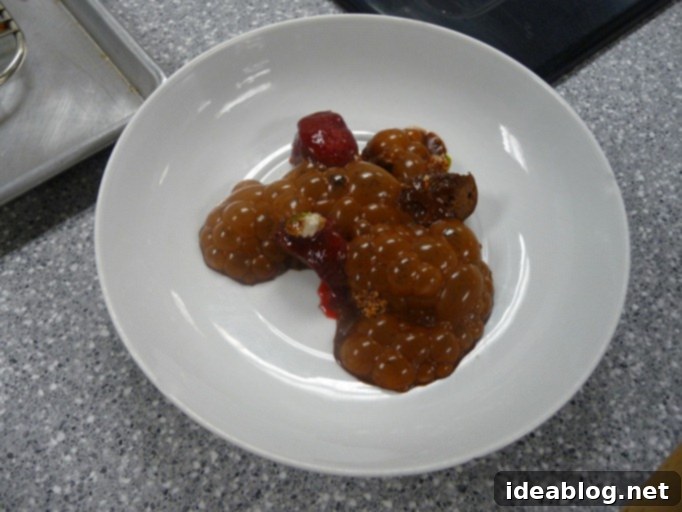
Chocolate (30-Sec Microwaved) Sponge Cake with Raspberry Sheets & Cocoa Bubbles: Speed, science, and surprising textures.
Our instructor for the day was exceptionally well-versed in these cutting-edge techniques, having honed his skills over seven years at Jose Andres’s acclaimed Minibar in Washington D.C., a restaurant renowned for its experimental and innovative cuisine. While a few of the recipes and dishes we observed—and even created ourselves—might theoretically be replicated in a well-equipped home kitchen, the vast majority of what we made demanded either highly specialized equipment or exotic ingredients that are difficult for the average home cook to source. Beyond the specialized tools and components, the sheer labor intensity of many molecular gastronomy dishes was striking. This often translates into very small recipe yields, where an immense amount of effort is expended to produce just a few elegant bites, emphasizing quality, artistry, and precision over quantity.
The day commenced with an engaging demonstration of all the featured dishes, allowing us to grasp the theoretical underpinnings and visual appeal of each creation. After a brief interlude for lunch, the afternoon transitioned into hands-on kitchen work, where we had the opportunity to recreate any of the dishes we had witnessed earlier that morning. One of the defining characteristics of molecular gastronomy is its highly scientific nature. Unlike more intuitive forms of traditional cooking, where experience and sensory judgment often guide the process, this avant-garde approach is meticulously based on calculated recipes, precise scales, and weighing ingredients down to the smallest fraction of a gram. There’s little room for estimation; every element is controlled with exacting detail to achieve specific chemical and physical transformations in the food.
Perhaps the most audacious and conceptually challenging dish of the day was the aforementioned zucchini “risotto.” This creation was a playful deconstruction of traditional creamy risotto, reimagined entirely from the humble seeds of the zucchini. If you’re envisioning a labor-intensive process, I can absolutely assure you it was even more so in practice. The core technique involved an initial, somewhat bizarre step: boiling whole zucchinis until they became incredibly soft. Following this, each zucchini was carefully cut lengthwise, and then the tedious, almost meditative process of literally removing the seeds one by one began. As I observed this painstaking task, I couldn’t help but spare a sympathetic thought for the unfortunate extern who might have been assigned this exact duty in a high-end molecular gastronomy kitchen for hours on end.
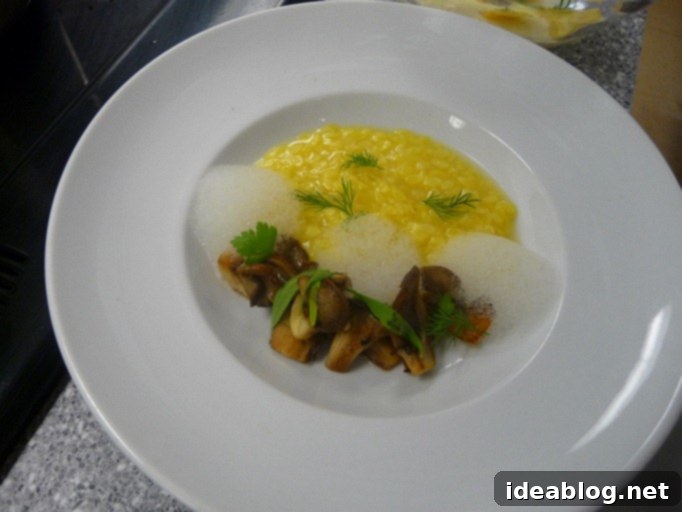
The truly disheartening aspect of this endeavor was the yield: after processing almost three whole zucchinis, you’d likely end up with a mere three to four tablespoons of precious seeds, which formed the ‘risotto’ component. It was, frankly, quite depressing from a volume perspective! Many molecular gastronomy dishes involve a creative reinvention of traditional components, and this zucchini ‘risotto’ was no exception. It also featured “Parmesan water,” crafted by simmering equal parts Parmesan cheese and water, then cooling and carefully skimming the resulting liquid for a clear, savory essence. Additionally, there was a risotto base made from rice flour and water, designed to emulate the creaminess of a traditional risotto without actual rice, alongside a delicate zucchini froth to add an airy, ephemeral quality. Witnessing all these disparate elements come together, orchestrated with such precision, was truly fascinating and showcased the intricate artistry involved in modern cuisine.
This is probably the point where your curiosity about the final taste truly peaks! Unfortunately, I must candidly admit that while the finished dish was visually stunning and intellectually intriguing, it wasn’t nearly as impressive to eat as it was to behold. To be fair, I didn’t get the opportunity to taste it until about 20-30 minutes after it was meticulously assembled, which might have certainly impacted its optimal flavor and texture. While the overall texture and aesthetic undeniably resembled a classic risotto, my taste buds, accustomed to the comforting richness of actual arborio rice, were not easily deceived. I found myself subtly wishing I were indulging in a bowl of real risotto (oops!). Perhaps if I had been served this masterpiece fresh, in the refined ambiance of a molecular gastronomy restaurant, my impression might have been entirely different, who knows?
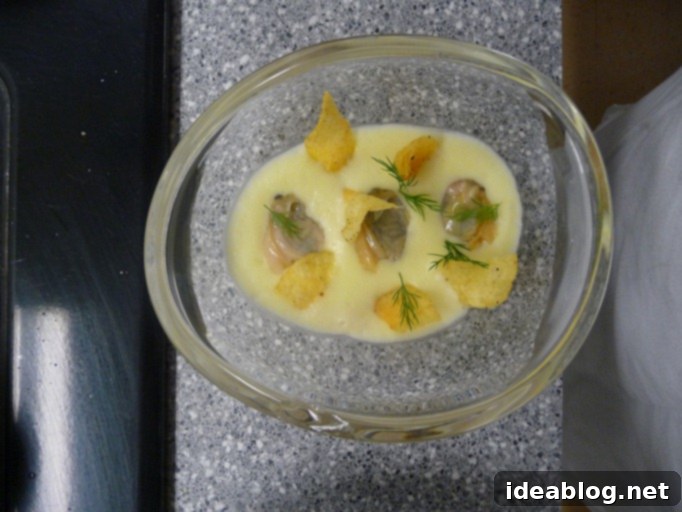
Another compelling dish we meticulously crafted during the day was an elegant composition of clams served with a delicate potato mousse, a rich bacon cream, and a velvety sweet onion puree. This particular creation stood out as potentially the most “re-creatable” at home, though it would still present a significant challenge for the average cook. The potato mousse was prepared similarly to traditional mashed potatoes, aiming for an even creamier and less stiff consistency. However, the crucial difference lay in its presentation: the smooth mixture was loaded into an iSi bottle. It was then “creamed” or aerated using gas chargers, which infused it with nitrous oxide, transforming it into a remarkably fluffy and airy potato cloud. I can readily envision the immense utility of this technique in a bustling restaurant kitchen, as it brilliantly resolves the perennial issue of holding mashed potatoes, which inevitably degrade in texture and quality over time. Instead, chefs can simply keep the iSi bottle warm, piping out fresh, perfectly aerated potato mousse as needed, and even store the mixture effectively for a day or two without loss of quality.
The accompanying bacon cream was a study in simplicity and flavor concentration, created by expertly pureeing cooked, crispy bacon with fresh cream until perfectly smooth and emulsified. The sweet onion puree offered a wonderful counterpoint, made by slowly caramelizing onions to bring out their natural sugars, then blending them until they reached an incredibly silky, uniform texture. For an unexpected yet delightful textural contrast, our instructor chose to garnish the dish with crushed kettle potato chips, providing a surprising crunch that elevated the sensory experience—a slightly unconventional touch, wouldn’t you agree? These meticulous layers of texture and flavor are hallmarks of modern gastronomic innovation.
Beyond the groundbreaking culinary techniques and the delicious (and sometimes perplexing) dishes, the absolute highlight of the day, as always, was simply reconnecting and catching up with my wonderful classmates. We are all currently engaged in vastly different externship experiences, each pushing the boundaries of our individual culinary interests. Despite our diverse paths, I think we are all collectively shocked and amazed that we now have only about a month left before our rigorous culinary program officially concludes, and we proudly graduate. While it certainly feels like a considerable amount of time has passed since Day One—a day that, almost comically, was devoted entirely to the singular, foundational task of mastering French onion soup—the entire journey, from basic knife skills to molecular marvels, has flown by at an incredible pace. This final class was a fitting capstone, showcasing the vast spectrum of culinary possibilities and cementing our readiness to step into the dynamic world of professional kitchens, armed with both traditional wisdom and innovative foresight.
